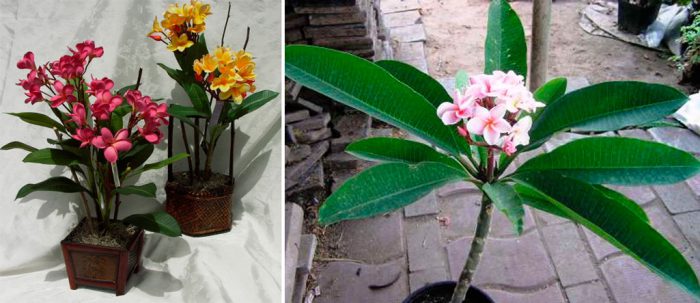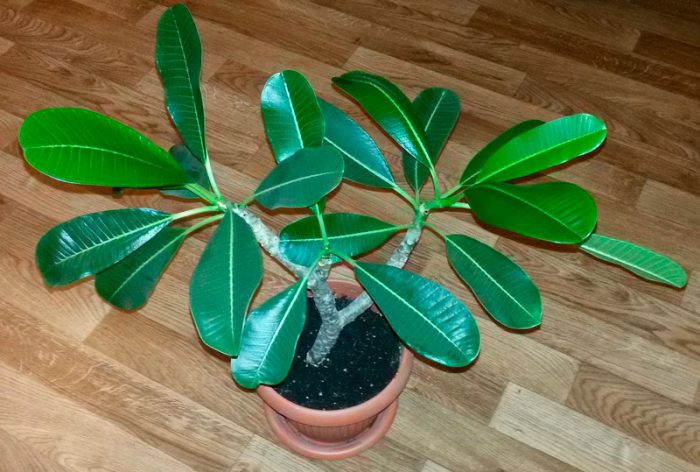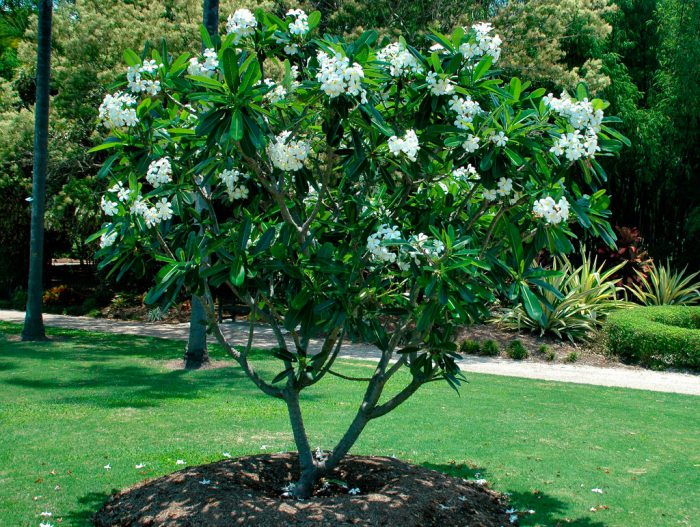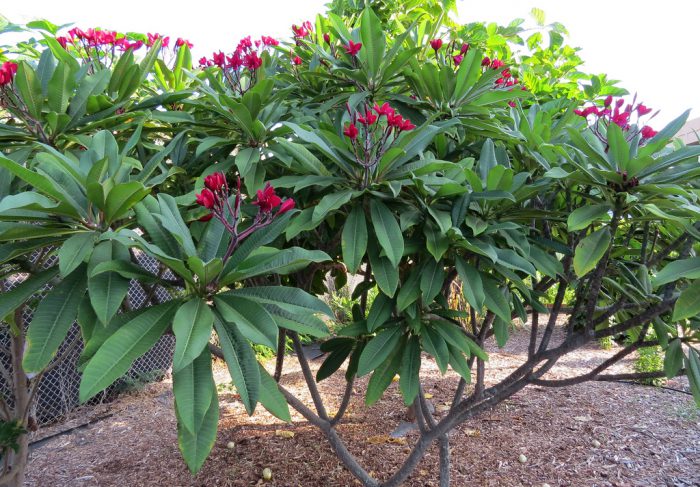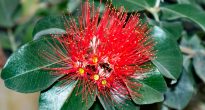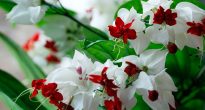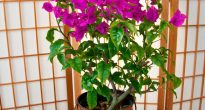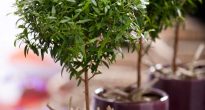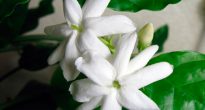Kind of like plumeria (Plumeria) is directly related to the kutrov family. This genus includes about 65 different plant species. French botanist Charles Plumer, who lived in the 17th century, was very famous, and it was in honor of him that this genus got its name. In nature, such a plant can be found in the north of South America.
This genus is represented by trees and shrubs. At home, plumeria is grown because of the lovely flowers that can be painted in pale pink, white or yellow. Flowering lasts a very long time, almost the entire summer period. The flowers are quite large (up to 10 centimeters in diameter).
In mid-latitudes, such a plant is rarely grown, so it is rarely seen in flower shops. When kept in an apartment, this plant reaches 200 centimeters in height. Plumeria grows best in a greenhouse.
Content
Plumeria care at home
Illumination
This is a very light-loving plant. South-facing windows are perfect for placing it, because at least 6 hours a day it must be illuminated by direct rays of the sun, otherwise it will not bloom. It can also be grown on east or west facing windows. The north window is not suitable for growing, as due to too little light, flowering there will definitely not come. In the warm season, it is recommended to move the plant to fresh air. However, it is impossible to expose it immediately in the sun, but you should gradually accustom it. In this case, the plumeria must be protected from drafts, as well as from rain. A newly purchased plant should not be exposed to direct sunlight, as burns may form on the leaves.
Temperature regime
A very thermophilic plant. So, from the middle of spring to the end of the summer period, the temperature should be in the range from 25 to 30 degrees. In autumn, the temperature is gradually lowered, and in winter, it is necessary to ensure that it does not drop below 16 degrees.
How to water
In the warm season, when kept in an apartment, watering is carried out immediately after the top layer of the substrate dries out. To do this, use necessarily settled and soft water. In winter, it is necessary to water much less, but at the same time make sure that the soil does not dry out. Overflow for the plant is also very dangerous.In this regard, on cloudy summer days and during cool wintering, watering must be done very carefully.
Humidity
During active growth, plumeria is recommended to be sprayed systematically. For this, soft and well-settled (at least 24 hours) water is perfect. Also, in order to increase the humidity of the air, you can pour a little pebbles or expanded clay into the pallet, and then pour water into it. However, you must make sure that the bottom of the flowerpot does not come into contact with the liquid in the tray. When spraying, avoid getting water on the flowers.
Fertilizer
After the beginning of the period of intensive growth in spring, you should start feeding the plumeria, which is produced once every 2 weeks. Complex fertilizer for flowering plants is excellent for feeding. In the case when the plant is transferred to the street in the summer, it can be fertilized alternately by root and foliar. It is necessary to spray the foliage on both sides in the evening with a prepared solution. To do this, the amount of water that is used to dilute the required dose of fertilizer must be doubled. Spraying is carried out once every 1–1.5 weeks. In the autumn, the plant needs to be fertilized less often, and in the winter, it cannot be fed.
Dormant period
If the plant is grown in an apartment, then in winter it has a dormant period. It can last from 3 to 6 weeks (the duration directly depends on the species). During the dormant period, old leaves fall off the plumeria. After this period ends, young foliage begins to actively grow, as well as flowers.
Transplant features
The transplant is carried out at the beginning of the spring. While the young tree is subjected to this procedure annually, older specimens can be transplanted 1 time in 2 years. A flower pot should be chosen slightly (2 or 3 centimeters) larger than the previous one. In the absence of such a capacity, you can simply cut the root system by about 5 centimeters. At the bottom of the pot, you need to pour fresh earth mixture over the drainage layer. To create a suitable mixture, it is necessary to combine peat, turf and humus soil, as well as sand in a ratio of 1: 2: 1: 1. Don't forget to make a good drainage layer on the bottom of the pot. To do this, a fifth of it should be filled with broken brick and expanded clay, you can also use egg shells.
Seed propagation
For sowing seeds, small pots are used, the diameter of which is 6 centimeters. After the seedlings have a well-developed root system, they should be carefully transplanted (or better transferred) into pots with a diameter of 9 centimeters. The soil mixture is suitable for the one that is used for transplanting. Typically, a plumeria that grows from a seed has clear differences from the parent plant. Such a plant begins to bloom at two or three years of age.
Propagation by cuttings
Cutting is recommended in the last winter or early spring weeks. Cuttings must be cut at an oblique angle. After that, the cut must be moistened in water, and then in a means that stimulates root formation. To plant the cuttings, fill a third of the pot with an earth mixture, a third with perlite, and then add the earthen mixture again. The cutting is planted so that it is in an upright position, and its cut must be immersed in perlite. For successful rooting, you will need warmth from 25 to 28 degrees. To maintain this high temperature, bottom heating is recommended. You will need good lighting, if necessary, you can provide backlighting with fluorescent lamps. Watering is done carefully. Evidence of successful rooting will be the appearance of young leaves. This usually happens after 8-12 weeks. Watering should gradually become more abundant. Then they are transshipped into a large container and cared for as an adult plant. Flowering usually occurs after a year, but may start earlier.
Warning
This plant contains poison in the juice., which, if it comes into contact with the skin or mucous membrane, can cause serious irritation. If the juice gets on the mucous membrane or skin, you should urgently thoroughly rinse this place with plenty of water, which must be running.
Video review
Main types
White plumeria (Plumeria alba)
In the wild, you can meet in the Antilles. These trees can be up to 10 meters in height. The leaves are linear. On their seamy side are dense whitish hairs. At the leaf plate, the edges are slightly raised. The leaves are approximately 30 centimeters long and 7 centimeters wide. Fragrant small flowers (up to 2.5 centimeters in diameter) are white and have a yellowish eye.
Red Plumeria (Plumeria rubra)
Under natural conditions, you can meet in Mexico or Venezuela. Deciduous trees can be up to 5 meters tall. The egg-shaped leaves reach 50 centimeters in length and 15 centimeters in width. There are specimens, the seamy side of the leaves of which can be either smooth or have pubescence. As a rule, the apex of the leaves is obtuse, but there is also a sharply pointed one. Flowers are collected in a brush at the top of the stems, the diameter of which can reach 5 centimeters. In different varieties, flowers can be painted in different colors, for example, white, yellow, pink, red, and also lilac. Different varieties also differ in the shape of the leaves.

